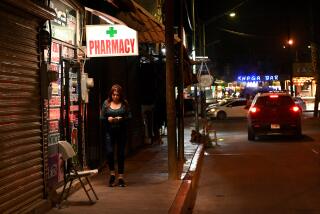Krokodil, more perilous than heroin, possibly surfaces in Arizona
- Share via
A highly addictive drug whose name derives from the green, scaly sores that develop on users’ rotting flesh was reported to have found a toehold in the United States this week.
In Phoenix, physicians told toxicologists at the Banner Good Samaritan Poison Control Center that they spotted symptoms consistent with krokodil, an intravenous drug that is prevalent in Russia and Eastern European countries, according to a statement released to the Los Angeles Times.
Although toxicology reports have yet to confirm the presence of krokodil, reports in the media sounded the alarm, prompting fascination and speculation.
“The Most Horrifying Drug in the World Comes to the US,” said Time magazine. Mother Jones minced no words: “Zombie Apocalypse Drug Reaches US: This Is Not a Joke.”
The appeal of news about krokodil (pronounced “crocodile”) stems partly from its dramatic consequences on the human body: The drug ravages the flesh, exposing the bones, destroying internal organs and leaving users vulnerable to infection. Users quickly develop abscesses and gangrene, and often amputation is the only way to protect a patient’s life.
Curiosity also stems partly from the do-it-yourself nature of the drug’s preparation.
According to New York’s Office of Alcoholism and Substance Abuse Services, it can be made with ordinary ingredients, including paint thinner, codeine, iodine, hydrochloric acid, red phosphorus, gasoline and lighter fluid.
Krokodil is essentially a back-alley version of desomorphine, which was introduced in 1932 as a less addictive version of morphine.
But according to a study in the Journal of Addictive Diseases, desomorphine turned out more addictive and up to 10 times stronger than the drug it was meant to replace, so it was mostly discontinued. Switzerland produced the drug until the 1950s, and today, desomorphine is banned in Austria and Germany.
The U.S. Drug Enforcement Administration has been tracking use of krokodil abroad for at least two years, where the drug has surged in popularity, especially in Russia. Up to 1 million people in Russia are estimated to use krokodil, according to New York’s Office of Alcoholism and Substance Abuse Services.
But has it reached the United States?
Absent any definitive proof that krokodil abuse has occurred, the DEA has -- so far -- labeled the Arizona cases anecdotal. Other reports of krokodil in the last two years in Alabama and Arkansas were never confirmed, agency spokesman Rusty Payne said.
“When I hear about about these things like krokodil, I’m skeptical,” Payne said. “I’m not believing it until I get a lab report.”
There’s still no evidence that it has entered the illicit drug market in the U.S., Payne said.
But toxicologists at the Arizona poison control center said they remain worried about krokodil usage, explaining that emerging drug habits are typically first seen by area physicians.
ALSO:
Major bridge in Wisconsin shut after drivers report troubling sag
Airline pilot dies after apparent heart attack forces emergency landing
Prison: O.J. Simpson not caught stealing cookies, oatmeal or otherwise
Twitter: @MattHjourno
More to Read
Sign up for Essential California
The most important California stories and recommendations in your inbox every morning.
You may occasionally receive promotional content from the Los Angeles Times.











